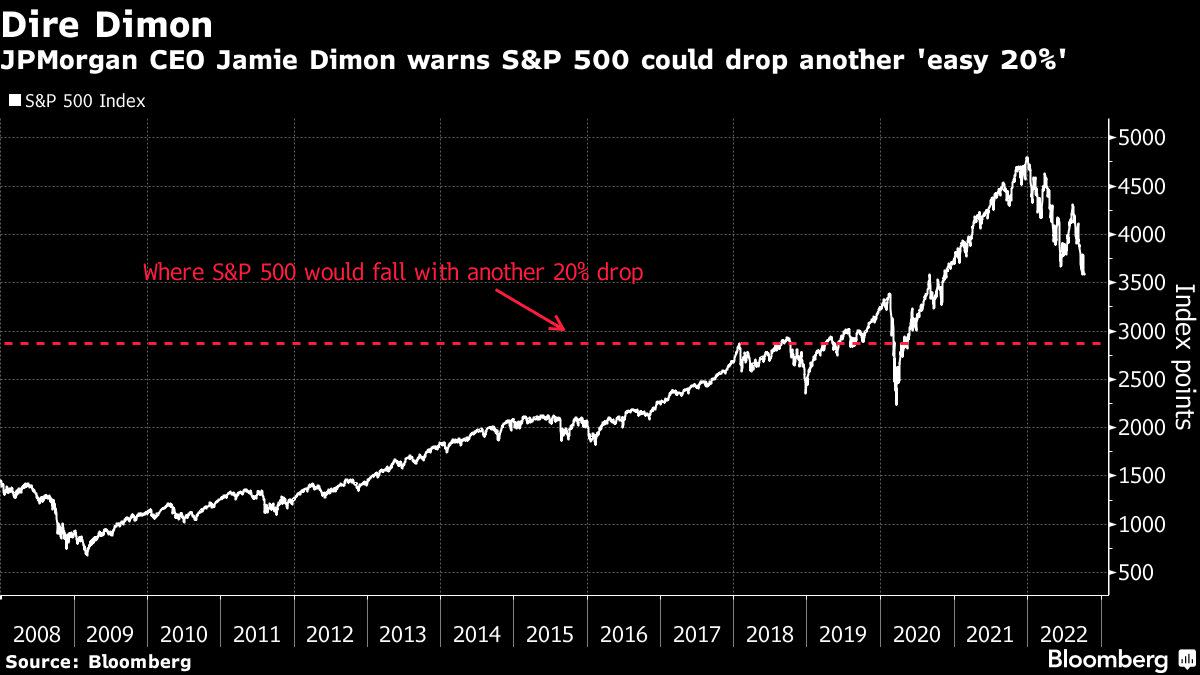
(Bloomberg) — JPMorgan Chase & Co.’s boss Jamie Dimon says the US stock market could suffer another “easy 20%” drop, which would push the benchmark index below 3,000 — a level it hasn’t seen since the depths of the coronavirus pandemic.
So what would another slide of that magnitude actually look like and which stocks would get hit hardest?
For one thing, it would be painful for investors, with technology and so-called growth shares likely taking the brunt of the suffering, with their elevated valuations becoming targets as borrowing costs rise. Such a decline would push the S&P 500 to 2,871 based on Tuesday’s close, shaving $6 trillion off the S&P 500’s current market value of $30 trillion.
The top five companies in the S&P 500 — Apple Inc., Microsoft Corp., Alphabet Inc., Amazon.com Inc. and Tesla Inc. — account for 21% of the index, creating risk for equity investors because any big declines from those shares can quickly steer broader markets lower.
“Do I think another 20% drop from here is likely? No. But there’s better than a 50% chance it could happen,” said Nick Giacoumakis, president of NEIRG Wealth Management, citing the steep equity downturn in the early 2000s. When the dot-com bubble burst, the S&P 500 lost nearly half of its value, shedding 49% from its peak in March 2000 to its ultimate low in October 2002, according to Bespoke Investment Group.
When the S&P 500 peaked in October 2007, it lost 57% of its value when it finally hit its low in March 2009 in the wake of the global financial crisis.
“That’s the magnitude of what Dimon is talking about,” Giacoumakis added. “Back then, we had an extreme run-up in exuberance similar to now, but instead of internet stocks now it’s SPACs and trillions of dollars in excess liquidity that has put the economy on steroids.”
During this year’s market rout, Amazon has shed more than 30%, while Tesla, Microsoft and Alphabet have all lost at least a third of their value. Apple — a stock that delivers stable earnings, and pays out a consistent dividend — hasn’t been shielded either this year, tumbling 21%. But Giacoumakis, who likes big tech, is more concerned about slumping chipmakers due to mounting growth concerns.
The S&P 500 is already down 25% from it’s Jan. 3 closing high. Another 20% decline from its high would push it about 40% below its peak — far beyond the average drawdown for bear markets.
Since World War II, there have been nine bear markets that have been accompanied with a US recession, with the S&P 500 declining 35% on average versus a 28% decline in bear markets that didn’t come with an economic downturn, according to CFRA.
A quick, back-of-the-envelope look at what Dimon says could happen to the market in the near future. Is he serious or just talking down expectations ahead of the bank’s earnings Friday?
“Dimon’s human. All he can do is make estimates on how the economic data is coming in,” Giacoumakis said. “We’re not in a recession yet, but I think it’s coming in the next three to nine months. So we have enough left in the equity bubble to drop another 10% to 15% from here, no sweat.”
©2022 Bloomberg L.P.